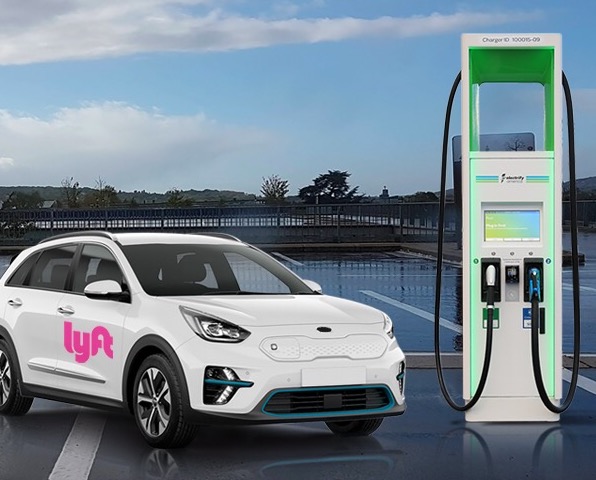Lyft plans to electrify all of its cars by 2030
Katie Fehrenbacher
Wed, 06/17/2020 – 10:00
In an unprecedented move, the ride-hailing company Lyft revealed Wednesday it plans to electrify every car on its platform — those owned by Lyft and rented to drivers as well as cars owned by drivers — by 2030.
The decade-long goal could result in millions of electric vehicles purchased for ride-hailing operations, encourage greater electric vehicle charging deployments and motivate stronger city, state and federal policies that could make EVs more economical. Lyft said its electric vehicle transition would remove more than 16 million tons of greenhouse gases from the atmosphere by 2030, equivalent to taking 3 million traditional cars off the roads.
On a media call Wednesday, Lyft Chief Policy Officer Anthony Foxx (former Secretary of Transportation under President Barack Obama) described the announcement as “a big deal.” Lyft co-founder and President John Zimmer said, “It’s on us to lead. We’re looking at bold opportunities. We intend to push hard and lean into this.”
Lyft has been exploring how to make its vehicle fleet more sustainable for a couple of years. But the new EV goal is a huge step for the company, which is in fierce competition with Uber and has been positioning itself as the friendlier ride-hailing choice.
Two years ago, Lyft launched a program to buy carbon offsets for all of the rides organized on its network. Lyft followed that up by launching “green mode” on its app. That feature lets riders in certain cities request a ride in an electric car, and drivers can rent electric vehicles through Lyft’s Express Drive program. In addition, Lyft operates bikes, e-bikes and e-scooters in certain regions and integrates its app with public transit data.
The new electric vehicle target, however, is a game-changing move that could transform the company and could provide environmental leadership to the rest of the ride-hailing industry. Lyft says in its release that “Lyft is willing to go first, but others need to follow if we want to hit mass-market electrification.”

The move won’t be easy. Lyft recently announced a first-quarter loss of $85.2 million on quarterly revenue of $955.7 million, and said it plans to cut $300 million in expenses by the fourth quarter. While EVs can be cheaper to operate, compared to gasoline costs, high battery costs still can make many EVs more expensive than traditional cars. Many regions also still lack adequate public charging infrastructure.
Shelter-in-place directives adopted to combat spread of the COVID-19 pandemic have battered ride-hailing companies as riders have stayed inside and avoided rides. But as states nationwide — and cities around the world — have started to open up for business, ride-hailing services have started to pick up.
Lyft says that the COVID-19 crisis forced the company to “rethink our priorities and focus on cost-effective investments. COVID-19 presented us with a choice to ‘hunker down or ‘grow back better’ by accelerating the transition to EVs. We are choosing to ‘grow back better’ by making sustainability an integral part of our path to profitability,” said the company in a statement.
Light-duty electric vehicles, such as the General Motor’s Bolt or the Nissan LEAF, are being adopted by some public and commercial fleets for administrative work and are helping companies and cities cut fuel costs. These vehicles are particularly attractive in states such as California that have strong policies in place to incentivize EVs.
But ride-hailing companies face a unique challenge when it comes to electrifying their fleets. Most cars on their network are owned by drivers, many of whom already operate on low margins.
Lyft will need to take a systemic approach to try to make electric vehicles more attractive to its drivers, including influencing state policies, providing incentives and encouraging infrastructure providers to build out EV chargers for drivers.

All of the initial projects will be in the United States.
Charging networks could be the biggest hurdle for the EV goal. A couple of years back in Washington, D.C., a lack of charging infrastructure flummoxed taxi drivers that agreed to adopt electric taxis. Like taxi drivers, ride-hailing drivers will have various needs for when they’d want to charge a vehicle, whether at home or at a ride-hailing charging depot, depending on where they live and their preferred routes.
While the pandemic and recession likely will dampen sales of passenger EVs in the short term, electric vehicles are still expected to grow substantially over the next two decades. The researchers at Bloomberg New Energy Finance predict there will be 500 models of EVs available by 2022, and 28 percent of new vehicle sales globally will be electric by 2030. That percentage is supposed to grow to 58 percent of new sales by 2040.
Aggressive policies around the world are helping spur this electric transition. California’s clean air regulators (the California Air Resources Board, or CARB) are in the process of implementing a first-of-its-kind clean miles standard that requires the ride-hailing companies to have a certain portion of the miles driven through their platforms be with zero-emission vehicles.
Under the bill SB 1014, Lyft and Uber are required to submit electrification plans at the beginning of 2022, with the program beginning in 2023.
In the first phase of the legislation, CARB established that the carbon emissions of Lyft and Uber’s vehicle fleet per passenger mile are over 50 percent higher than regular cars that drive on the roads. That’s largely because ride-hailing drivers travel around looking for passengers (called dead-head miles) for about 40 percent of their time.
The Union of Concerned Scientists (UCS) put out a report earlier this year that found that ride-hailing trips are 69 percent more polluting than the trips they replace. UCS’s Don Anair, the lead author on the report, said in an interview with GreenBiz: “It’s very clear that steps need to be taken to reduce climate emissions from ride hailing. Electrification is one of the largest steps to address these emissions.”
Lyft says it plans to join The Climate Group’s EV100 group, which asks members to make commitments to electrify 100 percent of their fleets. Lyft is already a member of the RE100 group, which has pledged to use 100 percent clean energy by 2030.
Updated: This article was updated June 17 with information from Lyft’s media call.
Ride Hailing
Electric Vehicles

Electrify America and Lyft partnered to bring chargers to Lyft EV drivers in Denver.



